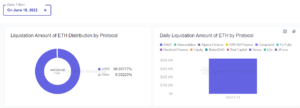
The following is a guest post from Venket Naga, CEO at Serenity Shield.
Would you give a stranger the keys to your house, permitting them to do whatever they wanted with the goods inside?
If you did, and that stranger went and crafted some fake replicas of your personalized jewelry to sell at auction, lent some of your clothes to a friend, and traded your television into a pawnbroker for a loan – would you still feel comfortable in saying you owned those items?
Surely not – nobody would, right? They’ve been stolen, compromised, taken from you.
Why do we all ignore that centralized cloud services such as Google Cloud, Microsoft Azure, and AWS are the go-to data guardians of decentralized blockchain projects? In effect, we’re willingly handing away the keys to our houses while pretending that we’re not.
With Gartner analysts expecting 85% of organizations to embrace a cloud first strategy by 2025, it’s time for blockchain to kick on and step up. That starts with facing up to the stark fact that the self-custodial narrative of decentralization does not stand up whilst this reliance on centralised systems remains at the core. As of yet, data ownership has not truly manifested beyond mere conceptualization in a whitepaper.
Reservations over this inherent discrepancy have become less hushed over time.
Since Google Cloud first began storing data on Bitcoin back in 2018, over 20 other blockchain networks – including the likes of Ethereum, Litecoin, and more recently, Polygon and Avalanche – have made the exploration of data possible through the service. As this number has risen, so has the volume of concern. Yet, action has been unable to manifest.
This is mainly due to the limitations of blockchain itself. Scalability, cost efficiency, and latency issues have prevented blockchain from evolving into an adequate practical solution for large data storage. Until now, there’s been no real challenge made against the reality of centralized alternatives having to plug the gap left by networks that continue to fly the flag of decentralization.
This is because developing decentralized storage solutions that are efficient, secure, and scalable can be technically challenging. It requires overcoming hurdles such as ensuring data redundancy, incentivizing participants to provide storage space, and maintaining data integrity across a decentralized network. Building the infrastructure itself also requires a significant investment of both time and money to develop and deploy the necessary hardware, software, and protocols.
Nonetheless, these hurdles must be overcome. It is crucial to sever the relationship between blockchain and cloud storage. If unresolved, the ugly side of Web2 will remain present in Web3: data breaches, manipulation, and corruption will persist; the risk of censorship will continue to increase; downtime will reoccur without warning; and the promised land of trust and transparency will fade into a mirage. At the core, decentralization will have failed, and the adoption of blockchain technology will be stopped in its tracks.
If blockchain is to realize its full potential in transforming the social dynamics of security, ownership, censorship resistance, the distribution of information and more, a solution must be deployed as soon as possible. Fully decentralized data storage will empower individuals and organizations to reclaim and build a more open, inclusive, and trustworthy digital infrastructure.
Decentralized Physical Infrastructure is the answer. In particular, global networks of DePIN data centers. They could offer a compelling holistic approach to the issue, fortifying key principles such as interoperability, data consistency, incentive mechanisms, and community governance.
With pre-existing Web2 foundations already interspersed across the globe, a network of distributed node validators could layer over top, tapping into pivotal points to create a system of redundancy that would guarantee integrity and security. Whilst this would require a monumental effort, both technically and financially, serious focus and collaboration between Web3 entities and governmental institutions could produce rapid progress.
Producing a robust solution would revolutionize data storage forever, enabling a fully decentralized process in which end users would gain new autonomy over privacy and monetization. By embracing the values of Web3 and building upon the foundations laid by Web2, a DePIN network could forge a new path in which a fine-tuned, resilient, and inclusive digital future can emerge.
The reconstruction of how we store, access, and manage data will surely knock-on effects that stretch beyond the realms of information and into the mechanisms through how we distribute power, wealth, and control.
For more information on DePIN projects, please see CryptoSlate’s DePIN crypto sector data below.
- SEO Powered Content & PR Distribution. Get Amplified Today.
- PlatoData.Network Vertical Generative Ai. Empower Yourself. Access Here.
- PlatoAiStream. Web3 Intelligence. Knowledge Amplified. Access Here.
- PlatoESG. Carbon, CleanTech, Energy, Environment, Solar, Waste Management. Access Here.
- PlatoHealth. Biotech and Clinical Trials Intelligence. Access Here.
- Source: https://cryptoslate.com/theres-a-delephant-in-the-room-and-depin-can-usher-it-out-of-the-door/
- :has
- :is
- :not
- $UP
- 20
- 2018
- a
- access
- across
- Action
- adequate
- Adoption
- against
- All
- already
- also
- alternatives
- an
- Analysts
- and
- answer
- approach
- ARE
- AS
- At
- Auction
- Autonomy
- Avalanche
- away
- AWS
- Azure
- back
- BE
- because
- become
- been
- began
- below
- between
- Beyond
- Bitcoin
- blockchain
- Blockchain networks
- blockchain projects
- blockchain technology
- both
- breaches
- build
- Building
- by
- CAN
- Censorship
- Censorship Resistance
- Centers
- centralised
- centralized
- ceo
- challenge
- challenging
- clothes
- Cloud
- cloud services
- cloud storage
- collaboration
- comfortable
- community
- compelling
- Compromised
- Concern
- consistency
- continue
- control
- Core
- Corruption
- Cost
- could
- crafted
- create
- crucial
- crypto
- crypto sector
- data
- Data Breaches
- data centers
- data storage
- Decentralization
- decentralized
- decentralized network
- depin
- deploy
- deployed
- develop
- DID
- digital
- discrepancy
- distribute
- distributed
- distribution
- do
- does
- Door
- downtime
- due
- dynamics
- effect
- effects
- efficiency
- efficient
- effort
- embrace
- embracing
- emerge
- empower
- enabling
- end
- ensuring
- entities
- ethereum
- evolving
- expecting
- exploration
- facing
- fact
- fade
- Failed
- fake
- feel
- financially
- First
- Focus
- following
- For
- forever
- forge
- Foundations
- friend
- from
- full
- fully
- future
- Gain
- gap
- Gartner
- Give
- Global
- global networks
- globe
- goods
- Google Cloud
- governance
- governmental
- guarantee
- Guardians
- Guest
- Guest Post
- handing
- Hardware
- Have
- having
- holistic
- House
- houses
- How
- http
- HTTPS
- Hurdles
- if
- ignore
- in
- Incentive
- incentivizing
- Including
- Inclusive
- Increase
- individuals
- information
- Infrastructure
- inherent
- inside
- institutions
- integrity
- Interoperability
- interspersed
- into
- investment
- issue
- issues
- IT
- items
- ITS
- itself
- jewelry
- jpg
- Key
- keys
- kick
- laid
- Land
- large
- Latency
- latency issues
- layer
- left
- less
- likes
- limitations
- Litecoin
- loan
- made
- mainly
- maintaining
- manage
- manifested
- Manipulation
- mechanisms
- mere
- Microsoft
- Microsoft Azure
- Mirage
- monetization
- money
- monumental
- more
- must
- NARRATIVE
- necessary
- network
- networks
- New
- no
- nobody
- node
- now
- number
- of
- offer
- on
- open
- organizations
- Other
- our
- out
- over
- Overcome
- overcoming
- owned
- ownership
- participants
- particular
- path
- Personalized
- physical
- pivotal
- plato
- Plato Data Intelligence
- PlatoData
- please
- plug
- points
- Polygon
- possible
- Post
- potential
- power
- Practical
- present
- press
- prevented
- principles
- privacy
- process
- produce
- Progress
- projects
- promised
- protocols
- provide
- rapid
- real
- Reality
- realize
- realms
- recently
- relationship
- reliance
- remain
- remains
- require
- requires
- resilient
- Resistance
- revolutionize
- right
- Risen
- Risk
- robust
- Room
- saying
- Scalability
- scalable
- sector
- secure
- security
- see
- sell
- serenity
- serious
- service
- Services
- Shield
- side
- significant
- So
- Social
- Software
- solution
- Solutions
- some
- Soon
- Space
- stand
- stark
- starts
- Step
- Still
- stolen
- stopped
- storage
- store
- storing
- stranger
- Strategy
- stretch
- such
- surely
- system
- Systems
- taken
- tapping
- technically
- Technology
- television
- that
- The
- Them
- These
- they
- this
- those
- Through
- time
- to
- top
- tracks
- traded
- transforming
- Transparency
- truly
- Trust
- trustworthy
- unable
- until
- upon
- users
- usher
- validators
- Values
- volume
- wanted
- warning
- we
- Wealth
- Web2
- Web3
- went
- whatever
- which
- while
- Whilst
- Whitepaper
- widget
- will
- willingly
- with
- without
- would
- yet
- you
- Your
- zephyrnet












